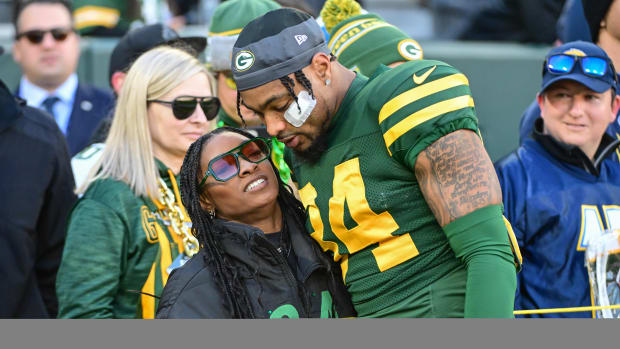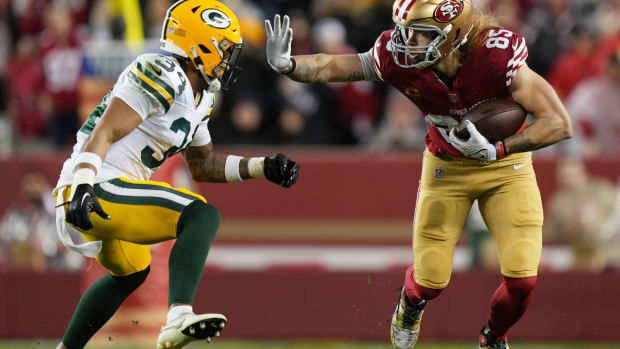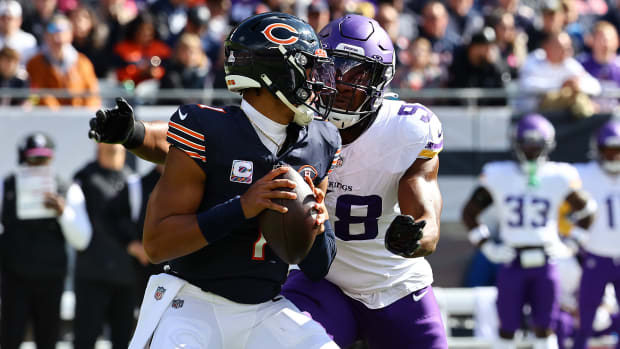Solid Ground Established for Bears Attack
Make no mistake, the Bears are rebuilding their team overall.
In terms of the offense, they are merely building one and not rebuilding.
They've never had one. How do you rebuild what you didn't have?
It's a franchise so entrenched in poor offensive approaches and execution that lack of offensive output is assumed.
In the last eight seasons, they've been 22nd or worse in scoring seven time and 21st or worse in yards gained seven times.
So coordinator Luke Getsy's approach for installing an offense and what he's implementing must be considered a start and not a fresh start.
What Getsy is doing is entirely different than what Matt Nagy did in his first year of 2018, when offensive failures were deodorized by a Bearsdefense that took the ball from opponents 36 times.
Here's how the implementation of offense is different from theoutset. Whether it will eventually be more successful is the real question but the way they're laying the groundwork looks solid.
1. The Dynamic
Nagy came in with an offense he took from the Kansas City Chiefs, couldn't find an NFL offensive coordinator who had installed a similar attack and then hired a former college coach who seemed a few steps down the rung from what the team needed to be successful in Mark Helfrich. They had a college coach trying to implement Nagy's offense, with Nagy overseeing what he was doing while he was supposed to be coaching the entire team.
Now, they have Matt Eberflus delegating both the offensive and defensive approaches to his coordinators. Getsy hasn't been an NFL play caller but at least he's been an NFL assistant in a successful system similar to the type of attack several other winning teams have been using such as Cincinnnati, San Francisco and the L.A. Rams.
It's not just using what the Kansas City Chiefs got away with using because they had someone as brilliant as Patrick Mahomes.
2. Conceptual Diversity
While this is a style of offense based on what Getsy learned with the Packers, it isn't taking the Packers offense and just running with it. There are varying elements to it.
"I've been very lucky to have been around, I mean the way coach (Mike) McCarthy had it set up and the way coach (Matt) LaFleur has it set up, collaborative effort is kind of the biggest thing," Getsy said. "And so I'm following suit there.
"I've got a really good staff that I love working with and they all work their butts off. They're all really smart, good football coaches, great teachers and so that part of it has been great honestly. It's been, I've been very blessed to have those guys in that room and I was fortunate enough to be in two different sets of groups up there in Green Bay that were drawn up very similarly."
The collaboration Getsy talks about is getting great input from experienced NFL assistants like Tyke Tolbert, the receivers coach who also is passing game coordinator, or from offensive line coach Chris Morgan. This is an assistant who has been part of a few explosive Shanahan-style offenses as well as other types of attacks. Quarterbacks coach Andrew Janocko had been with the Vikings since 2015 and before that two years with Tampa Bay. They're all well-qualified to contribute successful ideas from varied attacks they've seen or worked within.
"Everyone has been able to come in and implement things that they like, introduce things that they like," Getsy said. "This isn't my offense, this is our offense."
So it's not one man's offense, taken from another team and thrust in to the hands of a coordinator who might not even have been qualified to run it.
Nagy talked about the "Bears offense," being different from the Chiefs offense. It really wasn't in concept. It was different in talent.
When an offense borrows from succesful roots and has conceptual diversity, it's stronger. They can always turn to some other means of attack.
Nagy's attack had been totally stymied for 2 1/2 seasons before they turned to running more wide zone blocking concepts and getting Mitchell Trubisky out in the open with bootlegs. The running game opened up then more and it helped Trubusiky, who had always struggled. Even then it worked largely because they faced some weak defenses, but at least it was working and it was something different than the same old Kansas City approach with five pass blockers and inside zone blocking.
The new Bears attack shouldn't run into a wall and then turn to a drastically different approach like the Bears/KC offense of 2020 did because the various and alternate offensive concepts are going to be built into it already.
3. Player/System Fits
The idea of the offense is to design one broad enough to fit different types of players, but with the options suitable to specific skill sets so they're able to adjust or design it better for those players.
"So I'm taking a piece from everybody and everyone's experiences and we're making everything that we do the best that we can to fit the players that we have," Getsy said.
They're not trying to fit square pieces into round holes simply because Kansas City did it a certain way, as the past regime did.
Also, GM Ryan Poles and Ebeflus/Getsy are doing a better collaborative job on talent acquisition already than Nagy/Pace did generally for four years.
The Bears didn't draft a receiver or offensive lineman in the second round but when they did take one in Round 3 they got one with the qualities that fit this offensive system well. Velus Jones' combination of speed and ability to run through tacklers at an SEC level is much different than what they could have found in players like Cincinnati's Alec Pierce or North Dakota State's Chrisitian Jones. Both might be talented but Jones is the player with better speed than both, who is strong yet older and proven against better competition.
The Bears' best bit of collaboration in the last regime was David Montgomery as a back ideally suited for an inside zone scheme because of his ability to make tacklers miss and then run past them, or to run through tackles. There weren't many more players suited ideally to what they were doing. Possibly Justin Fields fit that, but his athletic ability is more a fit for almost any type of offense. In the draft, they didn't find a smaller, faster receiver type who is ideal for the old system until they selected Darnell Mooney. The receiver corps overall seemed unsuited for what they were trying to do. They didn't draft Tyreek Hill or Mecole Hardman types with real world class speed and when they had to go get some in free agency last year they were players like Marquise Goodwin, older retreads who had injury pasts or other flaws.
In this draft already, besides Jones, they have already taken four offensive linemen who all have better wide zone blocking fits than the linemen drafted under Pace were ideally fitted for that scheme.
Twitter: BearDigest@BearsOnMaven




